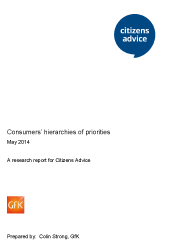Consumer engagement with the market: where do energy and other regulated markets fit in a consumer hierarchy of priorities?

Persistent disengagement is a common characteristic across many regulated markets. This leads to low switching levels on the demand side, meaning competition gives way to complacency on the supply side.
Despite many studies into why people don’t switch, and subsequent attempts at improving the process of switching and raising awareness of it as a way to save money, there remains a sustained lack of engagement. This challenges the underlying assumption that consumers are ready, willing and able to engage in these markets, drive competition and deliver benefits for all.
This research project aimed to understand what was going on from another angle. Citizens Advice wanted to explore the way in which people engage with different markets, and whether the very nature of certain sectors such as energy, mean that engagement will never be an attractive option.
The research aimed to establish whether consumers have a ‘hierarchy of priorities’ that determines how much time they allocate to shopping around in markets; and if so, where the electricity and mains gas supply, telecommunications and financial services markets fit into the hierarchy.
Policy Manager Liz Coll's Blog
To do this, Citizens Advice commissioned Gill Wales to undertake a major literature review in order to understand how consumers engage with markets and, in particular, how much time they allocate to all consumer tasks.
The report Consumers engagement with markets and the implications for their use of time [ 0.88 mb] examined many different aspects of engagement with markets (browsing, online and offline search behaviour, loyalty, switching, redress, consumer capabilities, etc) across more than 20 markets, drawing on knowledge from many sectors, academics and consumer bodies.
This wide-ranging analysis informed the design of new research from GfK Consumers hierarchies of priorities [ 2.3 mb] to test how much time is spent in regulated versus unregulated markets and whether there is evidence of a hierarchy. Given the difficulty of measuring this, a three stage approach was used:
-
Face-to-face interviews using an omnibus survey to establish which markets and for how long consumers shopped around, as well as where they would prioritise their time to find the best deals. The data collected was formed from consumers’ self-reporting.
-
Passive monitoring of website usage using GfK’s consumer panel, to measure how long consumers are browsing websites in different markets. This generated data based on actual rather than reported usage.
-
An experimental study using controlled conditions to measure task choice and time taken and whether interventions based on behavioural economics principles could influence consumers to engage in shopping tasks in different markets. This was based on actual rather than reported usage.
This research approach provides a triangulated data set on which to measure and assess a consumer hierarchy of priorities and explore the effect of interventions on this hierarchy, as well as other more established factors.
Interventions must start by understanding and respecting the time poor, information rich world people live in and are realistic about the appeal of energy shopping in such a crowded consumer landscape.


